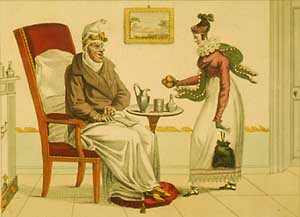What were the
factors which determined the development of vaccines for the treatment
of disease?

|
A niece visits her smallpocked uncle
and gives him presents
|
|

|
Jenner performing the first vaccination
|
the first significant step in the fight against infectious disease
was made in 1796 with discovery of a vaccine to prevent smallpox by
Edward Jenner. Jenner had become aware of the fact that milkmaids who
had suffered from a mild illness, cowpox, were unlikely to catch the
much more serious smallpox disease. Jenner experimented on a child,
introducing cowpox into the bloodstream. Later, the child was inoculated
with smallpox, but did not catch the disease. Jenner's method had proved
much safer than the fashionable technique of inoculation, which had been
brought to Britain from Turkey by Lady Montague. Despite opposition from
the medical establishment, many of whom made a good income from
inoculation, the government backed Jenner's claims; by 1853, vaccination
had become compulsory for infants.
Louis Pasteur was a French chemist who in 1867 was able to
demonstrate for the first time that germs caused disease. Pasteur went
on to develop vaccines for chicken cholera, anthrax and rabies. the new
science of bacteriology was advanced further by a German scientist,
Robert Koch. Using microscopes and innovative methods of staining germs,
Koch was able to identify specific germs as being responsible for the
cause of disease. In 1882-3, he identified the microbes responsible for
tuberculosis (TB) and cholera.
A rivalry developed between Pasteur and Koch, based in part on the
tension which existed following France's defeat in the Franco-Prussian
war of 1870-1. Both scientists were recognised in their own countries
for their work, and set up with research centres. In 1881, Pasteur,
successfully trialled a vaccine which protected against anthrax in
animals. Koch, who quickly heard of the breakthrough by telegram,
attempted unsuccessfully to discredit Pasteur. When, in the following
year, he had the opportunity to treat a boy with rabies called Joseph
Meister, Pasteur succeeded in developing a rabies vaccine.
Think about
this:
- Although rivals, Koch and Pasteur were helped by each other's
discoveries
- there was a gap of nearly 100 years between the key discoveries of
Jenner and Pasteur
- Smallpox was an epidemic disease in the 18th century; now it has
been eradicated worldwide.
|